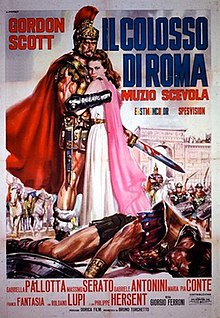Hero of Rome
| Hero of Rome | |
|---|---|
 | |
| Directed by | Giorgio Ferroni |
| Screenplay by |
|
| Story by | Alberta Montanti[1] |
| Starring | |
| Cinematography | Augusto Tiezzi[1] |
| Edited by | Antonietta Zita[1] |
| Music by | Angelo Francesco Lavagnino[1] |
Production companies |
|
Release date |
|
Running time | 90 minutes[1] |
| Countries |
|
| Language | Italian |
Hero of Rome (Italian: Il Colosso di Roma) is a 1964 sword and sandal film set in Rome in 508 BC, and depicts the expulsion of the last kings of Rome and the legend of Gaius Mucius Scaevola.
Plot
[edit]The city-state of Rome has just expelled its Etruscan overlords and become a republic. The Etruscans declare war in an attempt to regain their territory. The warrior Scaevola is captured trying to assassinate king Porsenna, and threatened with torture unless he gives them strategic information. Scaevola instead thrusts his right hand into a brazier and lets it burn, demonstrating that he loves Rome too much to care about physical pain, and warns the king that many other Romans would do the same.
The awed Porsenna releases him and sues for peace after learning the truth about how the Romans banished their last king, Lucius Tarquinius Superbus. However, Tarquin still wants to continue the war to regain his throne, and orders his men to kill Mucius later. Surviving the ambush, Mucius returns to Rome to lead his countrymen, but the damage to his hand prevents him from wielding a sword in his right hand again.
The Roman Senate manages the war badly, and it becomes clear that only Scaevola can lead his countrymen to victory. He trains himself to fight with his left hand, and is soon able to return to battle and defeat the Etruscan kings.
Cast
[edit]- Gordon Scott as Gaius Mucius Scaevola
- Gabriella Pallotta as Cloelia
- Massimo Serato as Lucius Tarquinius Superbus
- Roldano Lupi as Porsenna
- Gabriele Antonini as Arunte
- Maria Pia Conte as Valeria
- Franco Fantasia as Claudio
Release
[edit]Hero of Rome was released in Italy with a 90-minute running time on June 25, 1964.[1] Some of the early video prints confused the correct order of the reels.[2]
Reception
[edit]A anonymous reviewer in the Monthly Film Bulletin reviewed a dubbed version titled Arm of Fire. [3] The review declared that the films narrative was "unconvincing and improbable" and that the dialogue was hampered by English dialogue that was "on the level of the cartoon strip" while the "climactic spectacle is competently handled, but other ocular highlights are few."[3]
References
[edit]- ^ a b c d e f g h i Kinnard & Crnkovich 2017, p. 98.
- ^ Hughes 2011, p. 55.
- ^ a b "Colosso Di Roma, Il (Arm of Fire), Italy, 1964". Monthly Film Bulletin. Vol. 32, no. 379. British Film Institute. August 1965. pp. 122–123.
Bibliography
[edit]- Hughes, Howard (2011). Cinema Italiano - The Complete Guide From Classics To Cult. London - New York: I.B.Tauris. ISBN 978-1-84885-608-0.
- Kinnard, Roy; Crnkovich, Tony (2017). Italian Sword and Sandal Films, 1908-1990. McFarland. ISBN 978-1476662916.
External links
[edit]- Hero of Rome at IMDb
- 1964 films
- French historical adventure films
- Films set in ancient Rome
- Films based on classical mythology
- Films set in Italy
- Films directed by Giorgio Ferroni
- Films set in the 6th century BC
- Films scored by Angelo Francesco Lavagnino
- Sword-and-sandal films
- Cultural depictions of Lucius Tarquinius Superbus
- 1960s Italian-language films
- 1960s Italian films
- 1960s Italian film stubs
